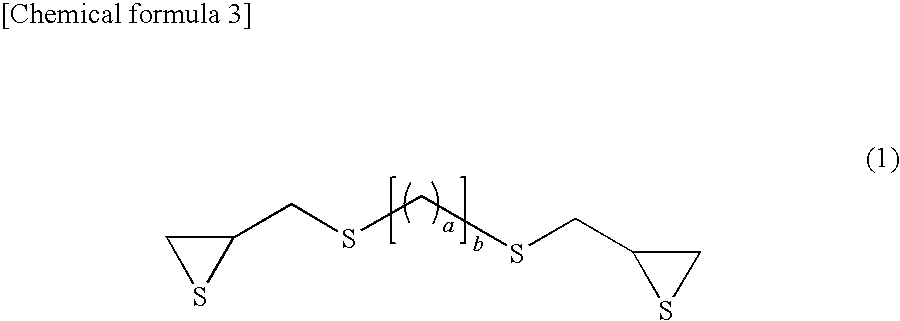Composition for resin and optical lens obtained therefrom
a technology of optical lenses and resins, applied in the field of compositions for resins and optical lenses obtained therefrom, can solve the problems of difficult to perform a usual cast polymerization operation including filtration, and the tonality of obtained materials is significantly deteriorated occasionally, so as to facilitate a cast polymerization operation, reduce the viscosity of compositions, and improve the refractive index of optical materials.
- Summary
- Abstract
- Description
- Claims
- Application Information
AI Technical Summary
Benefits of technology
Problems solved by technology
Method used
Image
Examples
example 1
[0126]29 parts by weight of sulfur as the (a) compound (hereinafter, referred to as the “a-1 compound”), 71 parts by weight of bis(β-epithiopropyl)sulfide as the (b) compound (hereinafter, referred to as the “b-1 compound”), and 14 parts by weight of bis(mercaptomethyl)disulfide as the (c) compound (hereinafter, referred to as the “c-1 compound”) were mixed well at 50° C. to be uniform. Next, 0.15 parts by weight of 2-mercapto-1-methylimidazole as a preliminary polymerization reaction catalyst was added to the mixture. While the mixture was stirred well at 50° C., a preliminary polymerization reaction was performed on the mixture until sulfur was not deposited even when the mixture was cooled down to 30° C. The time required to finish the reaction was 30 minutes. Then, to this preliminarily polymerized composition for a resin, 1 part by weight of the c-1 compound (15 parts by weight in total), 0.03 parts by weight of tetrabutylphosphonium bromide as the (d) compound, and 0.1 parts b...
example 2
[0128]The procedure of Example 1 was repeated except that 19 parts by weight, instead of 14 parts by weight, of the c-1 compound was incorporated. The evaluation results of the viscosity of the composition for a resin after the degassing and 2 hours later, and the refractive index, the Abbe number, the heat resistance and the tonality of the obtained optical material are shown in Table 1.
examples 3 to 14
[0135]Compositions for a resin were prepared in the same manner as in Example 1 except that the a-1 compound, the b-1 compound and the c-1 compound were changed to the compounds shown in Table 2 below and that the amount of each compound was changed to the amount shown in Table 2 below. The viscosity of each composition for a resin after the degassing and 2 hours later, and the refractive index, the Abbe number, the heat resistance and the tonality of each obtained optical material were evaluated in the same manner as in Example 1.
TABLE 2Composition: parts by weight(a) compound(b) compound(c) compoundOther compoundEx. 3Sulfur (a-1): 29Bis(β-epithiopropyl)sulfideBis(dimercaptomethyl)disulfide(b-1): 71(c-2): 15Ex. 4Sulfur (a-1): 29Bis(β-epithiopropyl)sulfideBis(dimercaptomethyl)disulfide(b-1): 71(c-2): 20Ex. 5Sulfur (a-1): 19Bis(β-epithiopropyl)disulfideBis(mercaptomethyl)disulfide(b-2): 81(c-1): 15Ex. 6Sulfur (a-1): 19Bis(β-epithiopropyl)disulfideBis(mercaptomethyl)disulfide(b-2): 81...
PUM
| Property | Measurement | Unit |
|---|---|---|
| Temperature | aaaaa | aaaaa |
| Temperature | aaaaa | aaaaa |
| Temperature | aaaaa | aaaaa |
Abstract
Description
Claims
Application Information
 Login to View More
Login to View More - R&D
- Intellectual Property
- Life Sciences
- Materials
- Tech Scout
- Unparalleled Data Quality
- Higher Quality Content
- 60% Fewer Hallucinations
Browse by: Latest US Patents, China's latest patents, Technical Efficacy Thesaurus, Application Domain, Technology Topic, Popular Technical Reports.
© 2025 PatSnap. All rights reserved.Legal|Privacy policy|Modern Slavery Act Transparency Statement|Sitemap|About US| Contact US: help@patsnap.com



